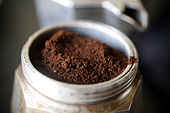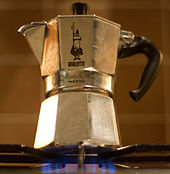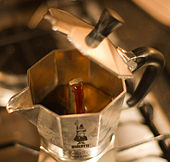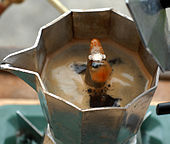- Moka pot
-
Moka pot 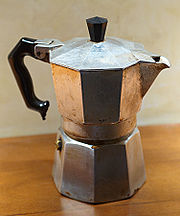
Manufacturer Bialetti Release date 1933 The moka pot, also known as a macchinetta (literally "small machine") or "Italian coffee pot", is a stove top coffee maker which produces coffee by passing hot water pressurized by steam through ground coffee. It was first patented by inventor Luigi De Ponti for Alfonso Bialetti in 1933. Bialetti Industrie continues to produce the same model under the name "Moka Express".
The moka pot is most commonly used in Europe, but also in Latin American countries. It has become an iconic design, displayed in modern industrial art museums such as the Museum of Modern Art, the Cooper–Hewitt, National Design Museum, the Design Museum,[1] and the London Science Museum. Moka pots come in different sizes, from one to eighteen 50 ml cups.[2] The original design and many current models are made from aluminium with bakelite handles.
Contents
Variations and brands
Traditionally, moka pots are made of aluminium and are used over a flame or electric range. The aluminium moka pots cannot be used on induction stoves. There are, however, also many stainless steel models available.[3] Electric self-heating moka pots are also available.
Brikka is a modified moka pot manufactured by Bialetti. It incorporates a weighted valve as a pressure regulator on top of the nozzle that allows pressure to build up inside the water tank in a manner similar to a pressure cooker. This increases the pressure of the water flowing through the coffee grounds, and increases the extraction temperature beyond the boiling point of water at atmospheric pressure.
Mukka Express is modified moka pot also manufactured by Bialetti that allows milk to be frothed and mixed with the coffee during brewing. The name, "Mukka", is a pun on the Italian for cow, "mucca". Bialetti also manufactures several stainless steel moka pots, i.e.: Musa, Class or Venus.
Alessi is an Italian kitchenware manufacturer known for their moka pots. Bodum has added a "Chambord" stove top espresso maker to their line which, while differing in appearance, is similar in function to the moka pot. Cuisinox also markets several models of moka pots in both aluminium and stainless steel.
Vev Viganò is an Italian manufacturer that specialises in stainless steel moka pots. Their product lines include Kontessa, Itaca, Vespress and Carioca.
Bellman makes a stainless steel moka pot, the CX-25 Series, operating at higher pressure and capable of creating a crema. It also has a wand to steam liquids, such as milk for cappuccino.[4]
The brand Volturno has been manufacturing moka pots in Argentina for many decades;[5] the name Volturno is sometimes used synonymously with moka pot there.[6]
Brewing coffee with a moka pot
Fill the boiler (marked A in the diagram) with water almost up to the safety release valve and insert the funnel-shaped metal filter (B). Add finely-ground coffee to the filter as shown below. Tightly screw the upper part (C, which has a second metal filter at the bottom) onto the base. Place the pot on a suitable heat source, bring the water to its boiling point, and thereby create steam in the boiler.
A gasket ensures a tightly closed unit and allows for pressure to safely build up in the lower section, where a safety valve provides a necessary release in case this pressure should get too high (with clean filters, that should not happen). For best results, fill up the entire filter with coffee and place over medium to medium-high heat.
The steam eventually reaches a high enough pressure to gradually force the surrounding boiling water up the funnel through the coffee powder and into the upper chamber (C), where the coffee is collected. When the lower chamber is almost empty, steam bubbles mix with the upstreaming water, producing a characteristic gurgling noise.
As with percolators, the pot should not be left on the stove so long that the coffee boils. Ideally, with a little practice, it should be removed from the heat before it actually starts gurgling - usually, when only about half of the top chamber has been filled.
Moka coffee vs. drip coffee
The flavour of stovetop espresso coffee depends greatly on bean variety, roast level, fineness of grind, and the level of stovetop heat used. Due to the higher than atmospheric pressure involved, the mixture of water and steam reaches temperatures well above 100 °C, causing a more efficient extraction of caffeine and flavours from the grounds, and resulting in a much stronger brew than that obtained by drip brewing, but with a different flavour.
Moka coffee vs. espresso coffee
Moka pots are sometimes referred to as stove-top espresso makers and produce coffee with an extraction ratio similar to that of a conventional espresso machine. Depending on bean variety and grind selection, Moka pots can create a foam emulsion, known as crema. However, the maximum pressure for coffee extraction which can be achieved with a Moka pot is 1.5 bar [citation needed]. According to the Italian Espresso National Institute and the Specialty Coffee Association of America, an espresso must be made using a precise extraction pressure of 9 bar.[7][8] So, while a Moka coffee pot can produce a crema similar to espresso's, different equipment is required to make a true espresso.
Maintenance
Moka pots require periodic replacement of the rubber seal and the filters, and a check that the safety release valve is not blocked.
After use, a thin coat of oily coffee residue is left lining the interior of the stems, filters and upper chamber. It is said to be desirable to retain this residue, as it subsequently prevents coffee from acquiring an unpleasant metallic taste through contact with the aluminum wall.[9] A moka pot should be cleaned well with hot water but no soaps or detergents, which strip away the protective coating. With aluminium moka pots it is important to dry all parts with soft cloth and store them separately as any moisture trapped inside the pot can cause the aluminium to corrode.
Notes
- ^ GREENBAUM, HILARY (September 1, 2011). "Who Made That Moka Express?". nytimes.com. http://6thfloor.blogs.nytimes.com/2011/09/01/who-made-that-moka-express/.
- ^ "Moka Express factsheet" (PDF). Bialetti. http://www.bialetti.it/files/catalogue/attachments/moka%20italia.pdf. Retrieved 2009-03-01.
- ^ "Stainless Steel Stovetop Espresso Maker". http://www.espresso-machines-and-coffee-makers.com/stainless-steel-stovetop-espresso-maker.html. Retrieved 2011-06-15.
- ^ CoffeeCrew: "Bellman Cappuccino Maker reviewed". http://www.coffeecrew.com/gear/392-bellman-cappuccino-maker-reviewed. (Accessed on December 7, 2009)
- ^ "Volturno - Cafeteras Express" (in Spanish). http://www.volturno.com.ar/principal.htm. Retrieved 15 December 2010.
- ^ "Familia de Artistas" (in Spanish). Página/12. http://www.pagina12.com.ar/diario/suplementos/las12/13-5380-2009-12-18.html. Retrieved 15 December 2010. "sirven café de una cafeterita Volturno"
- ^ "Espresso Italiano Certificato". Istituto Nazionale Espresso Italiano. http://espressoitaliano.org/doc/EIC%20-%20Eng%20-%20LQ.pdf. Retrieved 30 Jan 2011.
- ^ "Espresso and classic drink Wiki". http://www.baristaexchange.com/forum/topics/espresso-and-classic-drink?xg_source=activity. Retrieved 30 Jan 2011.
- ^ "Brewing italian coffee with a moka pot". http://www.portanapoli.com/Eng/Gastronomy/moka-pot.html.
References
- Rombauer, Irma S.; Marion Rombauer Becker; Ethan Becker (August 1997). The Joy of Cooking. Scribner. pp. 28–29. ISBN 0-684-81870-1.
External links
 Media related to Moka Expresses at Wikimedia CommonsCategories:
Media related to Moka Expresses at Wikimedia CommonsCategories:- Italian brands
- Italian beverages
- Coffee preparation
- Industrial designs
Wikimedia Foundation. 2010.


